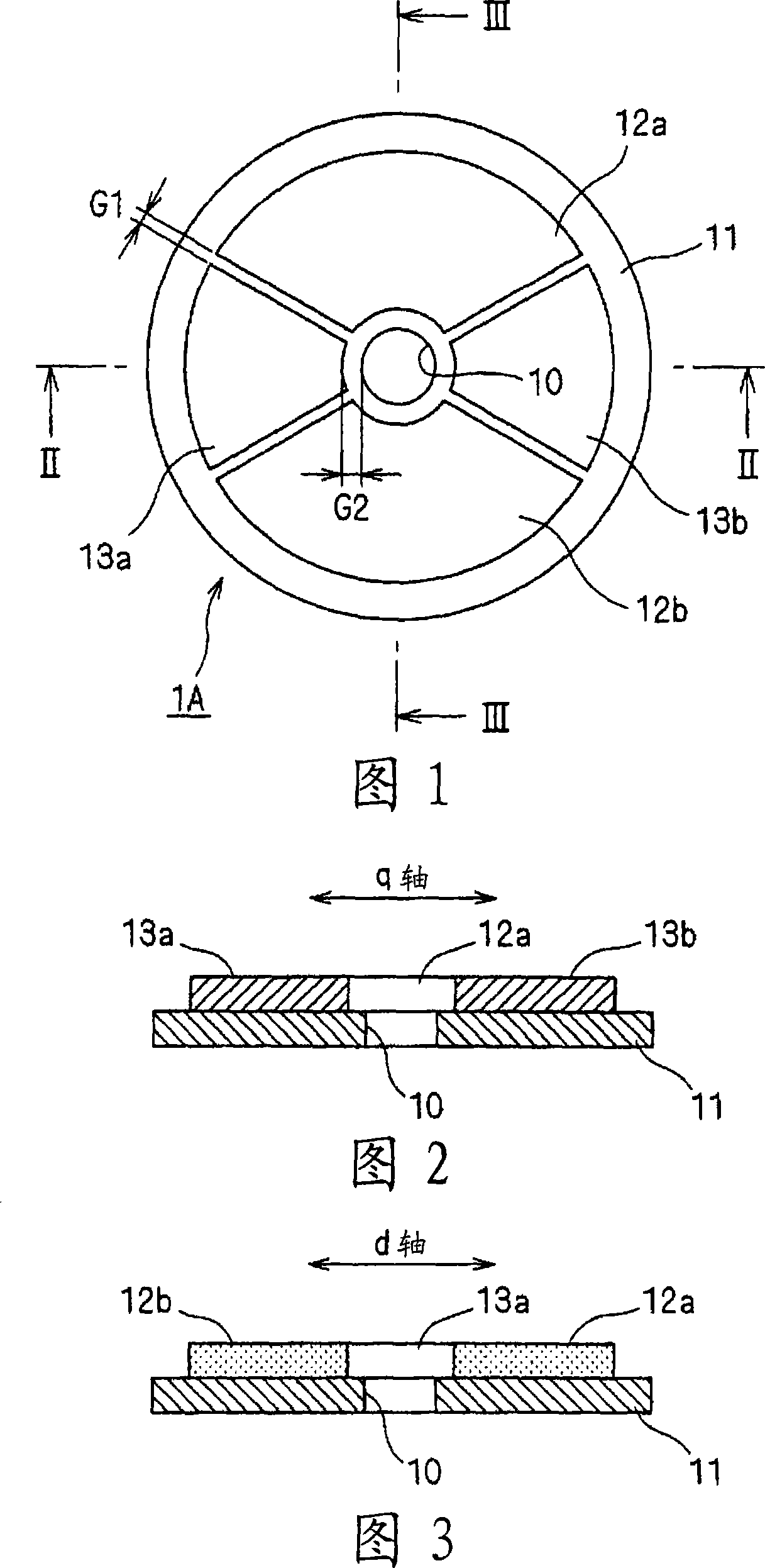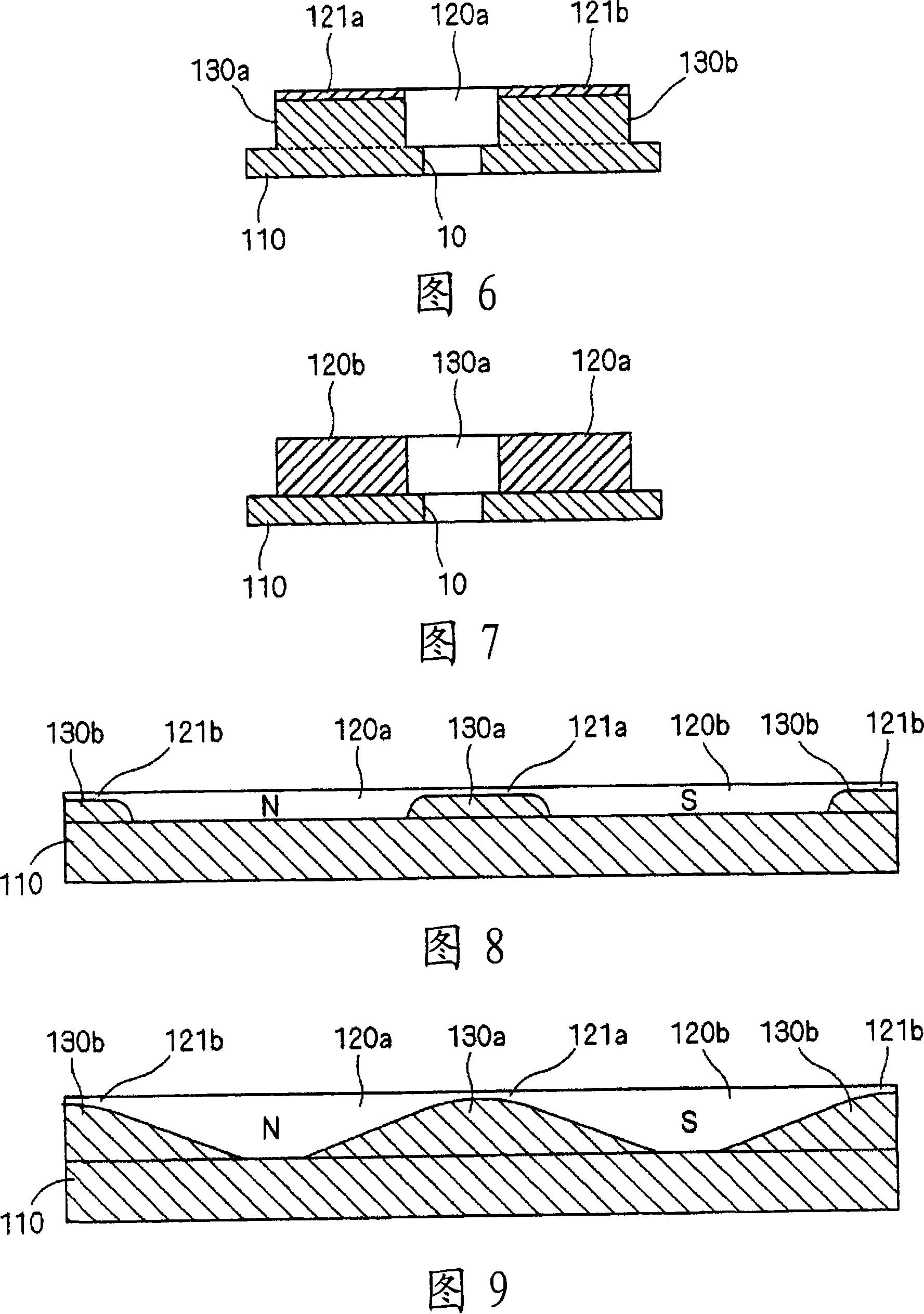Rotor, axial gap type motor, driving method of motor, compressor
A motor and rotor technology, applied in the field of motors, can solve problems such as increased cogging torque and hindered interaction
- Summary
- Abstract
- Description
- Claims
- Application Information
AI Technical Summary
Problems solved by technology
Method used
Image
Examples
no. 1 Embodiment approach
[0226] 1 is a diagram illustrating the configuration of a rotor 1A according to a first embodiment of the present invention, and is a plan view of the rotor 1A when the stator constitutes a motor together with the stator, viewed from the stator (not shown) side. 2 and 3 are cross-sectional views at positions II-II and III-III respectively.
[0227] The rotor 1A has magnets 12a, 12b, magnets 13a, 13b, and a base plate 11 on which they are placed. That is, the rotor 1A can be used as a rotor whose number of pole pairs is 1 (the number of poles is 2). A shaft hole 10 is also provided at the center of the base plate 11 .
[0228] A plurality of magnets 12a, 12b are arranged in a ring shape with polarity symmetry around the shaft hole 10, and its magnetic pole surface is perpendicular to the direction of the rotation axis (the extension direction of the rotation shaft inserted in the shaft hole 10 is parallel to the vertical direction of the paper surface. ). The magnet 12a has ...
no. 2 Embodiment approach
[0245] 5 is a diagram illustrating a configuration of a rotor 1B according to a second embodiment of the present invention, and is a plan view of a case where the rotor constitutes a motor together with a stator (not shown) viewed from the stator side. 6 and 7 are cross-sectional views at positions VI-VI and positions VII-VII, respectively.
[0246] The rotor 1B has magnets 120a, 120b, magnets 130a, 130b, and a base plate 110 on which they are placed. That is, the rotor 1B may be used as a rotor having one pole pair (two poles). A shaft hole 10 is also provided at the center of the base plate 110 .
[0247] The substrate 110 and the magnets 130 a and 130 b are integrally formed using, for example, a high magnetic permeability material such as iron or dust core. That is, the substrate 110 also functions as a back yoke. It is preferable to use powdered iron cores for the substrate 110 and the magnets 130 a and 130 b from the viewpoint of integration and reduction of iron loss...
no. 3 Embodiment approach
[0264] FIG. 12 is a diagram illustrating the configuration of a rotor 1C according to a third embodiment of the present invention, and is a plan view of a state in which it constitutes a motor together with a stator (not shown) viewed from the stator side. 13 and 14 are cross-sectional views of positions XIII-XIII and positions XIV-XIV, respectively. Compared with the rotor 1A ( FIGS. 1 to 3 ) shown in the first embodiment, the rotor 1C has magnets 14 a , 14 b disposed on the magnetic pole surfaces of the magnets 12 a , 12 b so as to be magnetically independent, covering the magnets 12 a , 12b structure on the pole face. Here, the case where magnets 14a, 14b and magnets 12a, 12b are isomorphic is exemplified. Since FIG. 12 is a plan view viewed from the stator side, the situation that the magnets 12a, 12b are hidden by the magnets 14a, 14b are indicated by reference numerals 14a (12a), 14b (12b), respectively. The magnetic pole surfaces of the rotor 1C serve as surfaces on t...
PUM
 Login to View More
Login to View More Abstract
Description
Claims
Application Information
 Login to View More
Login to View More - R&D
- Intellectual Property
- Life Sciences
- Materials
- Tech Scout
- Unparalleled Data Quality
- Higher Quality Content
- 60% Fewer Hallucinations
Browse by: Latest US Patents, China's latest patents, Technical Efficacy Thesaurus, Application Domain, Technology Topic, Popular Technical Reports.
© 2025 PatSnap. All rights reserved.Legal|Privacy policy|Modern Slavery Act Transparency Statement|Sitemap|About US| Contact US: help@patsnap.com



